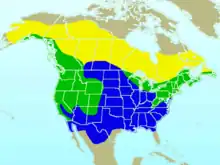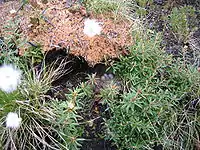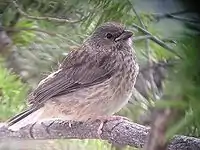Dark-eyed junco
The dark-eyed junco (Junco hyemalis) is a species of junco, a group of small, grayish New World sparrows. This bird is common across much of temperate North America and in summer ranges far into the Arctic. It is a very variable species, much like the related fox sparrow (Passerella iliaca), and its systematics are still not completely untangled.
| Dark-eyed junco | |
|---|---|
 | |
| Scientific classification | |
| Domain: | Eukaryota |
| Kingdom: | Animalia |
| Phylum: | Chordata |
| Clade: | Dinosauria |
| Class: | Aves |
| Order: | Passeriformes |
| Family: | Passerellidae |
| Genus: | Junco |
| Species: | J. hyemalis |
| Binomial name | |
| Junco hyemalis | |
 | |
| Approximate range in North America Breeding range Year-round range Wintering range | |
| Synonyms | |
(but see text) | |
Taxonomy
The dark-eyed junco was formally described by the Swedish naturalist Carl Linnaeus in his landmark 1758 10th edition of Systema Naturae as Fringilla hyemalis. The description consisted merely of the laconic remark "F[ringilla] nigra, ventre albo. ("A black 'finch' with white belly") and a statement that it came from America.[2] Linnaeus based his description on the "Snow-Bird" that Mark Catesby had described and illustrated in his The Natural History of Carolina, Florida and the Bahama Islands.[3]
The Bill of this Bird is white: The Breast and Belly white. All the rest of the Body black; but in some places dusky, inclining to Lead-color. In Virginia and Carolina they appear only in Winter: and in Snow they appear most. In Summer none are seen. Whether they retire and breed in the North (which is most probable) or where they go, when they leave these Countries in Spring, is to me unknown. [italics in original][3]
The type locality was restricted to South Carolina by the American Ornithologists' Union in 1931.[4][5] The dark-eyed junco is now placed in the genus Junco that was introduced in 1831 by the German naturalist Johann Georg Wagler.[6][7] The genus name Junco is the Spanish word for rush, from the Latin word juncus.[8] Its modern scientific name means "winter junco", from the Latin word hyemalis "of the winter".[9]
Subspecies
Either 14 or 15 subspecies are recognised[7] which are grouped in two or three large or polytypic groups and three or four small or monotypic ones, all depending on the authority. These groups were formerly considered separate species, but they interbreed extensively in areas of contact. Birders trying to identify subspecies are advised to consult detailed identification references.[10][11]
Slate-colored group
.jpg.webp)
- slate-colored dark-eyed junco (J. h. hyemalis)
- Carolina dark-eyed junco (J. h. carolinensis)
- Cassiar dark-eyed junco (J. h. cismontanus; possibly a slate-colored dark-eyed junco (J. h. hyemalis) x Oregon dark-eyed junco (J. h. oreganus) hybrid)
These two or three subspecies have dark slate-gray heads, breasts and upperparts. Females are brownish-gray, sometimes with reddish-brown flanks.[10] They breed in the North American boreal forests from Alaska to Newfoundland and south to the Appalachian Mountains, wintering throughout most of the United States. They are relatively common across their range.
White-winged group
.jpg.webp)
- white-winged dark-eyed junco (J. h. aikeni)
This subspecies has a medium-gray head, breast, and upperparts with white wing bars. Females are washed brownish. It has more white in the tail than the other 14 subspecies. It is a common endemic breeder in the Black Hills of South Dakota, Wyoming, Nebraska, and Montana, and winters south to northeastern New Mexico.[12][10]
Oregon or brown-backed group
_(cropped).jpg.webp)
- Montana dark-eyed junco (J. h. montanus)
- Nevada dark-eyed junco (J. h. mutabilis)
- Oregon dark-eyed junco (J. h. oreganus)
- Point Pinos dark-eyed junco (J. h. pinosus)
- Laguna Hanson dark-eyed junco (J. h. pontilis)
- Shufeldt's dark-eyed junco (J. h. shufeldti)
- Thurber's dark-eyed junco (J. h. thurberi)
- Townsend's dark-eyed junco (J. h. townsendi)
These eight subspecies have blackish-gray heads and breasts with brown backs and wings and reddish flanks, tending toward duller and paler plumage in the inland and southern parts of its range.[11] Oregon dark-eyed juncos are also less commonly known as brown-backed dark-eyed juncos. This is the most common subspecies group in the West, breeding in the Pacific Coast Ranges from southeastern Alaska to extreme northern Baja California and wintering to the Great Plains and northern Sonora. An unresolved debate exists as to whether this large and distinct subspecies group is actually a separate species with eight (or nine, see below) subspecies of its own.
Pink-sided group
.jpg.webp)
- pink-sided dark-eyed junco (J. h. mearnsi)
Sometimes considered a ninth subspecies in the Oregon/brown-backed group, this subspecies has a lighter gray head and breast than the eight Oregon/brown-backed dark-eyed juncos, with contrasting dark lores. The back and wings are brown. It has a pinkish-cinnamon color that is richer and covers more of the flanks and breast than in the eight Oregon/brown-backed dark-eyed juncos. It breeds in the northern Rocky Mountains from southern Alberta to eastern Idaho and western Wyoming and winters in central Idaho and nearby Montana and from southwestern South Dakota, southern Wyoming, and northern Utah to northern Sonora and Chihuahua.[11]
Gray-headed group
.jpg.webp)
- gray-headed dark-eyed junco (J. h. caniceps)
This subspecies is essentially rather light gray on top with a rusty back. It breeds in the southern Rocky Mountains from Colorado to central Arizona and New Mexico, and winters into northern Mexico.[12][10]
Red-backed group
.jpg.webp)
- red-backed dark-eyed junco (J. h. dorsalis)
Sometimes included with the gray-headed dark-eyed junco proper as part of the gray-headed group, this subspecies differs from it in having a more silvery bill[11] with a dark-colored upper mandible and a light-colored lower mandible,[12][10] a variable amount of rust on the wings, and pale underparts. This makes it similar to the yellow-eyed junco (Junco phaeonotus), except for the dark eyes. It is found in the southern mountains of Arizona and New Mexico.[10] It does not overlap with the yellow-eyed junco in its breeding range.
Related species
The extremely rare Guadalupe junco (Junco insularis) was formerly considered to be a subspecies of this species (either included in the gray-headed group or placed in a seventh group of its own, the Guadalupe group), but is now treated as a separate species in its own right – perhaps a rather young one, but certainly this population has evolved more rapidly than the 14 or 15 subspecies of the dark-eyed junco on the mainland due to its small population size and the founder effect.[7]
Description
Adult dark-eyed juncos generally have gray heads, necks, and breasts, gray or brown backs and wings, and a white belly, but show a confusing amount of variation in plumage details. The white outer tail feathers flash distinctively in flight and while hopping on the ground. The bill is usually pale pinkish.[12]
Males tend to have darker, more conspicuous markings than females. The dark-eyed junco is 13 to 17.5 cm (5.1 to 6.9 in) long and has a wingspan of 18 to 25 cm (7.1 to 9.8 in).[12][13] Body mass can vary from 18 to 30 g (0.63 to 1.06 oz).[12] Among standard measurements, the wing chord is 6.6 to 9.3 cm (2.6 to 3.7 in), the tail is 6.1 to 7.3 cm (2.4 to 2.9 in), the bill is 0.9 to 1.3 cm (0.35 to 0.51 in) and the tarsus is 1.9 to 2.3 cm (0.75 to 0.91 in).[14] Juveniles often have pale streaks on their underparts and may even be mistaken for vesper sparrows (Pooecetes gramineus) until they acquire adult plumage at two to three months, but dark-eyed junco fledglings' heads are generally quite uniform in color already, and initially their bills still have conspicuous yellowish edges to the gape, remains of the fleshy wattles that guide the parents when they feed the nestlings.
The song is a trill similar to the chipping sparrow's (Spizella passerina), except that the red-backed dark-eyed junco's (see above) song is more complex, similar to that of the yellow-eyed junco (Junco phaeonotus). The call also resembles that of the black-throated blue warbler (Setophaga caerulescens) which is a member of the New World warbler family.[15] Calls include tick sounds and very high-pitched tinkling chips.[10] It is known among bird song practitioners as an excellent bird to study for learning "bird language."
A sample of the song can be heard at the USGS website[16] (MP3) or at the Cornell Lab of Ornithology website.[17]

Distribution and habitat
The dark-eyed junco's breeding habitat is coniferous or mixed forest areas throughout North America. In otherwise optimal conditions it also utilizes other habitats, but at the southern margin of its range it can only persist in its favorite habitat.[18] Northern birds migrate further south, arriving in their winter quarters between mid-September and November and leaving to breed from mid-March onwards, with almost all of them gone by the end of April or so.[18][19] Many populations are permanent residents or altitudinal migrants, while in cold years they may choose to stay in their winter range and breed there.[18] For example, in the Sierra Nevada Mountains of eastern California, J. hyemalis populations will migrate to winter ranges 5,000–7,000 feet (1,500–2,100 m) lower than their summer range. Seasonally sympatric females show difference in migration and reproductive timing that is dependent on hormone and ovary regulation.[20] The migrant female J. hyemails experience delayed growth in the gonad to allow time for their seasonal migration. They then migrate down to the northeastern United States, where the resident subspecies is the Carolina dark-eyed junco (J. h. carolinensis). Female Carolina dark-eyed juncos have large ovaries and, therefore, do not experience gonadal growth delays because they are residents in the area. In winter, dark-eyed juncos are familiar in and around towns, and in many places are the most common birds at feeders.[12] The slate-colored dark-eyed junco (J. h. hyemalis) is a rare vagrant to Western Europe and may successfully winter in Great Britain, usually in domestic gardens.
Behavior and ecology
These birds forage on the ground. In winter, they often forage in flocks that may contain several different subspecies. They mainly eat seeds, supplemented by the occasional insect. A flock of dark-eyed juncos has been known to be called a blizzard.
Breeding
Dark-eyed juncos usually nest in a cup-shaped depression on the ground, well hidden by vegetation or other material, although nests are sometimes found in the lower branches of a shrub or tree. The nests have an outer diameter of about 10 cm (3.9 in) and are lined with fine grasses and hair. Normally two clutches of four eggs are laid during the breeding season. The slightly glossy eggs are grayish or pale bluish-white and heavily spotted (sometimes splotched) with various shades of brown, purple or gray. The spotting is concentrated at the large end of the egg. The eggs are incubated by the female for 12 to 13 days. The young leave the nest between 11 and 14 days after hatching.[21]
 A dark-eyed junco nest with eggs
A dark-eyed junco nest with eggs A fledgling pink-sided dark-eyed junco J. h. mearnsi) at about one month after hatching, Yellowstone National Park
A fledgling pink-sided dark-eyed junco J. h. mearnsi) at about one month after hatching, Yellowstone National Park
References
- BirdLife International (2021). "Junco hyemalis". IUCN Red List of Threatened Species. 2020: e.T22721097A138466281. doi:10.2305/IUCN.UK.2021-3.RLTS.T22721097A138466281.en. Retrieved 23 March 2022.
- Linnaeus, Carl (1758). Systema Naturae per regna tria naturae, secundum classes, ordines, genera, species, cum characteribus, differentiis, synonymis, locis (in Latin). Vol. 1 (10th ed.). Holmiae (Stockholm): Laurentii Salvii. p. 183.
- Catesby, Mark (1729–1732). The Natural History of Carolina, Florida and the Bahama Islands (in English and French). Vol. 1. London: W. Innys and R. Manby. p. 36, Plate 36.
- Committee on Classification and Nomenclature (1931). Check-list of North American Birds (4th ed.). Lancaster, Pennsylvania: American Ornithologist's Union. p. 345.
- Paynter, Raymond A. Jr, ed. (1970). Check-List of Birds of the World. Vol. 13. Cambridge, Massachusetts: Museum of Comparative Zoology. p. 63.
- Wagler, Johann Georg (1831). "Einige Mittheilungen über Thiere Mexicos". Isis von Oken (in German and Latin). 1831. Col 510–535 [526].
- Gill, Frank; Donsker, David; Rasmussen, Pamela, eds. (January 2022). "New World Sparrows, Bush Tanagers". IOC World Bird List Version 12.1. International Ornithologists' Union. Retrieved 4 February 2022.
- "Junco". Oxford English Dictionary (Online ed.). Oxford University Press. (Subscription or participating institution membership required.)
- Jobling, James A. (2010). The Helm Dictionary of Scientific Bird Names. London, United Kingdom: Christopher Helm. pp. 197, 212. ISBN 978-1-4081-2501-4.
- Sibley, David Allen (2000): The Sibley Guide to Birds. Alfred A. Knopf, New York, pp. 500–502, ISBN 0-679-45122-6
- Dunn, Jon L. (2002). "The identification of Pink-sided Juncos, with cautionary notes about plumage variation and hybridization". Birding. 34 (5): 432–443.
- Cornell Lab of Ornithology (2002): Bird Guide – Dark-eyed junco. Retrieved 20 January 2007.
- Rising, J.D. (2010) A Guide to the Identification and Natural History of the Sparrows of the United States and Canada. Christopher Helm Publishers, London, ISBN 1408134608.
- Sparrows and Buntings: A Guide to the Sparrows and Buntings of North America and the World by Clive Byers & Urban Olsson. Houghton Mifflin (1995). ISBN 978-0395738733.
- "Black-throated Blue Warbler (Dendroica caerulescens)". Birds in Forested Landscapes. Cornell Lab of Ornithology.
- Dark-eyed junco song at USGS website
- "Dark-eyed Junco Sounds, All About Birds, Cornell Lab of Ornithology". www.allaboutbirds.org.
- Ohio Ornithological Society (2004): Annotated Ohio state checklist Archived July 18, 2004, at the Wayback Machine
- Henninger, W.F. (1906). "A preliminary list of the birds of Seneca County, Ohio" (PDF). Wilson Bulletin. 18 (2): 47–60.
- Kimmitt, Abigail A.; Hardman, Jack W.; Stricker, Craig A.; Ketterson, Ellen D. (September 2019). Sockman, Keith (ed.). "Migratory strategy explains differences in timing of female reproductive development in seasonally sympatric songbirds". Functional Ecology. 33 (9): 1651–1662. doi:10.1111/1365-2435.13386. ISSN 0269-8463.
- "Dark-eyed junco life history". All About Birds. the Cornell Lab of Ornithology. 2019. Retrieved 21 October 2021.
External links
- Dark-eyed junco ID, including sound and video, at Cornell Lab of Ornithology
- Dark-eyed junco—Junco hyemalis—USGS Patuxent Bird Identification InfoCenter
- Juncos: What do we know?—An expert discussion of atypical individuals, the fine points of subspecific identification, and the proper understanding of the cismontanus population, from the ID-Frontiers mailing list (January 2004), supplemented with photographs and paintings.
- "Dark-eyed junco media". Internet Bird Collection.
- Dark-eyed junco photo gallery at VIREO (Drexel University)
